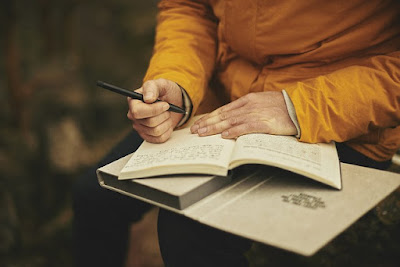When I was preparing my fall garden yesterday, I purposed to write down each and every step. I didn’t at the time, and if it weren’t for the dreary, rainy weather today, I might not still.
As William Allingham (d. 1889) wrote,
A man who keeps a diary, pays
Due toll to many tedious days;
But life becomes eventful--then
His busy hand forgets the pen.
But if yesterday’s gardening activities and thoughts aren’t noted, they’ll, no doubt, be forgotten, successes seldom repeated, failures repeated too often, and, perhaps, creative ideas remembered no more. We should, therefore, keep a garden diary.
I make this distinction between a garden diary and a mere journal. In most cases, a journal is simply a record of what has been done. A diary, however, may include much more. Yes, all those gardening details are included, but so are personal reflections, “thoughts and intents of the heart”, and other things besides.
What shall we write in?
There’s no rule here to follow; only preferences. I prefer a hard-bound octavo (8vo) size book, approximately 6” x 9”. Nothing smaller. My wife writes in a quarto (4to) 9.5” x 12” sketch book. Spiral-bound, paper-cover books don’t provide the permanence we desire.
There are gardening apps available for logging such things. I have one on my phone, in fact. It’s novel, but not as satisfying as putting a writing instrument to paper.
Now what? As any writer or artist will tell us, there’s nothing more intimidating than a blank page or canvas. But, begin we must. (Note: We mustn’t expect perfection at first. Writing will become easier as we go.)
So, what shall we include?
Details, details, details.
Every garden begins with a foundation, id est. soil. Gardening successes and failures usually depend on it. Whether planting in native or imported soils, let’s begin with a soil test. We can do it ourselves with a kit, available at garden shops or online, or stop by the nearby Cooperative Extension Office for assistance. Remembering that “this is only a test” and a snapshot of soil conditions at one place and time, the results are worth knowing. Believe it or not, soil test results can differ with the seasons, so take soil samples for testing the same time or times each year. Keep a record.
Times and seasons change, as does the weather. Take note of them (month, day, year) and weather as we work. Record early and late frosts, dry spells, and such. My grandparents were firm believers in “planting by the signs”, so kept a dog-eared Farmer’s Almanac close at hand all year long for handy reference. It made sense to them, and now to me. Let’s write it down. Did we or did we not plant during the right “sign”? Even if you’re not “a believer”, try it. You might be converted.
We should record the species and varieties in our gardens, their placement and spacing, their companions, and the sources of our seeds and plants. Those notes can be mighty important when we try to figure out later what went right or wrong. I even take note of the company brand names and “packed for” dates on seed packets.
Personal reflections.
I do more thinking in my garden than almost anywhere else. Before moving on too far beyond the moment, we may “set a spell” to compose a few lines. What does it matter if a bit of dirt gets on the paper? No one will see it, anyway. Dreams, creative ideas, future plans and prayers are fine subjects.
Souvenirs.
There’s no reason – none whatsoever – keeping us from using our garden diaries for pressing flowers and foliage. Though I haven’t done it recently, I’ll occasionally open an old volume to find a blossom or herb among the pages. Then, almost mysteriously, the fragile tissues will evoke memories of the time and place when they were tucked away. Other keepsakes might include such things as small newspaper or magazine clippings, photos, and empty seed envelopes.
Art for art’s sake.
Though it can be mighty frustrating, gardening is often inspirational. Sometimes romantic. With instrument in hand, let’s sketch some beautiful sight before us – a butterfly, fruit, flower, leaflet, a still life or landscape scene. Perhaps we can add a bit of watercolor, conté or colored pencil a little later.
If we’re inclined to poetry or prose, what better place to express ourselves without prying eyes judging our voices?
We might never become as accomplished as diarists Edith Holden or Samuel Pepys, nor should we judge ourselves by them, but our garden diaries may become more useful and precious to us in years to come because they are compositions of our very own and contain memories unique to ourselves.
Return to GoGardenNow.com.







